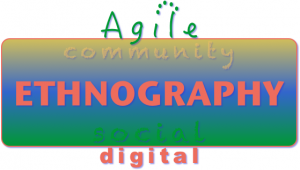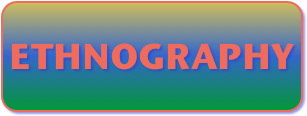 Agile Digital Ethnography uses an ethnographic research approach to analyze people’s online interactions. It creates a dynamic new market research capability that’s useful by itself and even more when used with surveys, focus groups, field work, and other primary research.
Agile Digital Ethnography uses an ethnographic research approach to analyze people’s online interactions. It creates a dynamic new market research capability that’s useful by itself and even more when used with surveys, focus groups, field work, and other primary research.
I have learned that Agile Digital Ethnography provides a unique combination of research results. I have used it on client engagements since 2006. Like primary research, it reveals people’s behavior, thoughts, emotions, and motivations in rich detail; however, because it’s secondary research, it’s faster and less costly than most other methods. It’s very useful when it’s conducted before primary research since its results can inform the design of primary research instruments.
How Agile Digital Ethnography Came to Be
 When social networks burst on the scene in the mid-2000s, I perceived their disruptive potential since I’d been on the front lines in PwC’s ebusiness transformation practice, which helped firms transform their organizations with “the Internet.” In 2008, I architected and released the Social Network Roadmap(SM), a full life cycle transformation framework, and I used it to serve large organizations that wanted to transform themselves with social media.
When social networks burst on the scene in the mid-2000s, I perceived their disruptive potential since I’d been on the front lines in PwC’s ebusiness transformation practice, which helped firms transform their organizations with “the Internet.” In 2008, I architected and released the Social Network Roadmap(SM), a full life cycle transformation framework, and I used it to serve large organizations that wanted to transform themselves with social media.
As I’d served and been employed by B2B clients, I instinctively used social networks to build relationships, and to do that, one must know people as individuals, so the ethnographic research processes and tools I developed were more intricate and in depth than the “social listening” tools that became the norm.
Before PwC, I’d been head of marketing for a pioneering distributed computing and object-oriented analysis/development firm, so I’d learned how to use agile development and project management to mitigate all kinds of risks inherent in innovation projects. I baked it into the Social Network Roadmap as well as my project management and business development processes.
Agile Digital Ethnography Core Practices
![]() Key parts of the Social Network Roadmap(SM) are in-depth analysis of Stakeholders (like personas but less about demographics and more about situations/motivations) and Workstreams (akin to journeys), with an explicit focus on Outcomes (like jobs-to-be-done). The tools I developed enabled me to curate and quantify interactions that involved Stakeholder–Workstream–Outcome combinations.
Key parts of the Social Network Roadmap(SM) are in-depth analysis of Stakeholders (like personas but less about demographics and more about situations/motivations) and Workstreams (akin to journeys), with an explicit focus on Outcomes (like jobs-to-be-done). The tools I developed enabled me to curate and quantify interactions that involved Stakeholder–Workstream–Outcome combinations.
I develop individual versions of tools for each project, and in most cases we analyze and measure how people affect each other through their interactions. This is crucial in follow-on social media projects because when we interact with people we want to measure the impact of our interactions on the group. So I analyze individuals’ interactions with each other and how those interactions affect the group. Moreover, I’ve learned that the most reliable general indicator for business impact—whether I’m serving a commercial, nonprofit, or government client—is how much the group trusts my client. I have learned to measure trust quantitatively.
Clients have consistently told me that the data we get (very specific in-depth conversations in digital public) is unlike any they’ve seen before.
The data we get and curate is very qualitative and rich with social context. By “social” I mean people’s intentions, emotions and motivations for doing things as well as very detailed descriptions of the logistics involved in their Workstreams.
So Agile Digital Ethnography is qualitative and quantitative. It offers a unique combination of quant+qual. Its analyses remove much of the risk of interacting with people and launching products because we come to understand how people think and feel about something, and we can measure the impact of our interactions with people in real-time. This enables teams to adjust their approaches quickly.
How Agile Digital Ethnography Relates to Other Research Methods
 By working with a wide range of clients, I have come to realize how valuable ADE is by itself, so now I also practice it as a stand-alone service. I’ve learned that it is very compatible with other types of market research. I’ll summarize some of my observations here:
By working with a wide range of clients, I have come to realize how valuable ADE is by itself, so now I also practice it as a stand-alone service. I’ve learned that it is very compatible with other types of market research. I’ll summarize some of my observations here:
- Since ADE is secondary research, it’s faster and less costly than interviews, focus groups, field work, direct observation, or diary studies. We study 100s or 1000s of subject rather than dozens.
- ADE is like field research in that it observes the target population where it self-organizes around targeted journey stages (and Outcomes).
- It resembles focus groups except people self-organize and aren’t pre-screened. But they are studied in collaborations that reveal extensive tacit information.
- ADE resembles user groups as participants self-organize and are studied in many-to-many interactions that reveal implicit behavior and motivations.
- Although ADE results are quantitative, they’re less statistically elegant than surveys; however they contain rich detail and combine qual and quant in a unique way.
- ADE is inherently open-ended; participants interact and stimulate each other to explore ideas collectively.
- ADE contains bias: only people who are on social media via computers or smart-phones are studied. All research contains bias since participants must opt in (i.e. focus groups).
- ADE’s bias is different since participants don’t explicitly opt in—as people on a neighborhood street don’t opt in to ethnographic study.
How Firms Use Agile Digital Ethnography
One of ethnography’s most powerful characteristics is that it observes people “in their natural habitats.” We get deep qualitative insights as well as their quantitative context. Our results are not self-reported, and since people are interacting in digital public, they know they are potentially being observed, and I hypothesize that their desire to “look good” brings out the best in people, although mileage varies extensively with the social context of the venue (community).
Therefore, ADE can be useful for anyone wanting to understand deeply the behavior and motivations of the people who are most relevant to their firms.
Its applications are many, but here are some popular ones:
- Customer experience: ADE measures customer Outcomes of clients and their competitors. It reveals relative strengths of brands/products. ADE gives customer service teams real-time insight into customer journeys, so they can serve people better.
- Product/Service design: ADE results reveal potential or existing users’ Outcomes for which they use products and services. Results are quant+qual; we can measure prevalence of frustrations and delights.
- Journey maps: CSRA uses ADE to add numerical validity to journey map stages. We discover Stakeholder (SH) journeys, create models and reveal their prevalence.
- Customer/User/Persona studies: ADE tests SH models using real-time live data from interactions in digital public. We measure the prevalence of each SH.
- Social media strategies: CSRA uses social media to grow sales by helping people attain Outcomes. ADE informs our strategies and measures results.
- Employee engagement: ADE can study employees behind the firewall and in digital public. We model and study high-performing employees and advise on engaging them.
- Digital transformation strategies: ADE can study the desires and frustrations of your customers, partners, employees, contractors, investors, etc. Having ethnographic insight into these stakeholders early on de-risks digital transformation significantly.
- Innovation strategies: ADE can study prospective users of a proposed innovation, whether a product, a business process, a service (i.e. service design), or even a new company or division.
Learning More
Here are some references in which I describe how firms use Agile Digital Ethnography for specific types of initiatives (use cases).
- Agile Digital Ethnography for Product Management
- Agile Digital Ethnography for Customer Experience
- Agile Digital Ethnography for Social Media Initiatives
- Agile Digital Ethnography for Business Innovation
- Agile Digital Ethnography for Design
- Agile Digital Ethnography for Employee Engagement
- Agile Digital Ethnography for Cross-Border Business

Leave a Reply
You must be logged in to post a comment.